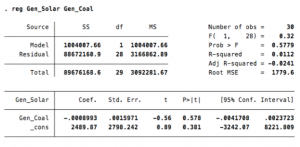The Effects of Solar Systems on Electricity Generation from Coal
Introduction
Electricity production depends on generating sources. These sources mainly consist of coal, fossil fuel, natural gas, renewables, etc. The world has not unlimited sources, but also it has a fast growing population. Therefore, renewable sources have become more significant factor of energy generation for the last 30 years. Moreover, as Bredehoeft states “In the Annual Energy Outlook 2014 Reference case, renewable electricity generation grows by 69% from 2012 to 2040” (2014, p.2). The forecast indicates amount of the limited sources of the world are decreasing more and more. Since, in the time the limited sources are decreasing, the value of unlimited renewable sources is increasing. This paper focuses on the factor of solar power on the electricity generation, and a comparison between the effect of solar power and coal on electricity generation.
The Dataset
To compare the effects of the factors, this paper uses a dataset that is published by the U.S. Energy Information Administration (EIA). “This publication includes statistics on total energy production, consumption, and trade; energy prices; overviews of petroleum, natural gas, coal, electricity, nuclear energy, renewable energy, and international petroleum; carbon dioxide emissions; and data unit conversion values” (U.S. Energy Information Administration). The dataset includes between 1984 and 2013. There are 2 variables and 60 observations in the dataset.
All the units of variables are given as Million Kilowatt.
Dependent Variable: Electricity Net Generation from Solar/PV, which ranges between 5.248 and 9252.155 MkW.
Independent Variable: Electricity Net Generation from Coal, which ranges between 1.341.681 and 2.016.456 MkW.
Research Question and Method
This paper looks at an answer for “Does solar power have any effect on energy generation from coal? “. To find the answer, dataset was analyzed by STATA by using Regression Analysis method. This statistical method searches if there is any relationship between two or more variables.
Hypotheses
H0: There is no association between electricity generation from coal and electricity generation from solar in the last 30 years.
Ha: There is an association between electricity generation from coal and electricity generation from solar in the last 30 years.
Results
STATA calculates all the dataset as regression analysis model and gives all the results what a researcher needs to analyze an issue. In our regression model STATA provides us a table as indicated below:

R2 value is 0.0112, which means there is an extremely weak association between electricity generation from coal and electricity generation from solar power. However, the R2 result is not enough to say the last result of regression analysis. P-value also needs to be analyzed.
P-value is 0.5779. A comparison of P-value with alpha gives us the correct results. Alpha value is 0.05 in this research.
P-value > Alpha value
The result of this comparison says there is no association between electricity generation from coal and electricity generation from solar in the last 30 years.
Conclusions

The chart shows us more clearly the lack of interaction. X-axis indicates the last 30 years, and Y-axis states Million Kilowatt. Although solar power usage has been changing, it does not have any effect on coal, yet. “During these years, the need of electricity has also intensely increased” (Bredehoeft, 2014). Therefore, solar power could not be a substitution of coal. However, the improvements on solar technology can make solar systems more effective element of electricity generation.
Bibliography
Bredehoeft, G. (2014). Renewable electricity projections show growth under alternative assumptions in AEO2014 . U.S. Energy Information Administration . U.S. Energy Information Administration .
U.S. Energy Information Administration. (n.d.). Total Energy. Retrieved November 25, 2014, from http://www.eia.gov/totalenergy/data/monthly/index.cfm
